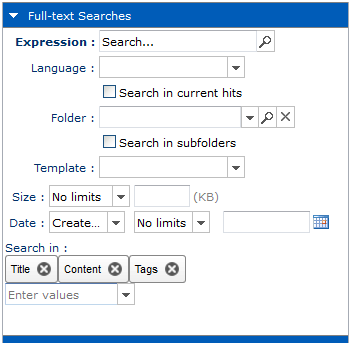La búsqueda de texto completo le permite buscar en el contenido de los documentos. Para realizar este tipo de búsqueda se tiene que introducir una expresión de texto.

Es posible restringir la búsqueda a una sola carpeta o aplicar algunos otros filtros como puede ver en el formulario. La expresión de texto se buscará en el contenido del documento y en los otros campos comprobar de la sección Búsqueda.
Indexación requerida
Los documentos que no están disponibles de inmediato para búsquedas de texto completo: en primer lugar necesitan ser indexados por el motor de búsqueda, por defecto esto sucede después de 30 minutos, pero en general depende de la configuración del sistema.
Como expresión puede usar cualquier composición palabras y, además puede utilizar caracteres especiales.
Wildcard Searches
To perform a single character wildcard search use the "?" symbol.
To perform a multiple character wildcard search use the "*" symbol.
The single character wildcard search looks for terms that match that with the single character replaced. For example, to search for "text" or "test" you can use the search:
te?t
Multiple character wildcard searches looks for 0 or more characters. For example, to search for test, tests or tester, you can use the search:
test*
You can also use the wildcard searches in the middle of a term.
te*t
Boolean Operators
Boolean operators allow terms to be combined through logic operators. The search system supports AND, "+", OR, NOT and "-" as Boolean operators. Note that these operators are all CAPS.
The OR operator is the default conjunction operator. This means that if there is no Boolean operator between two terms, the OR operator is used. The OR operator links two terms and finds a matching document if either of the terms exist in a document. This is equivalent to a union using sets. The symbol || can be used in place of the word OR.
To search for documents that contain either "computational objects" or just "computational" use the query:
"computational objects" computational
or
"computational objects" OR computational
AND
The AND operator matches documents where both terms exist anywhere in the text of a single document. This is equivalent to an intersection using sets. The symbol && can be used in place of the word AND.
To search for documents that contain "computational objects" and "Computational effort" use the query:
"computational objects" AND "Computational Effort"
+
The "+" or required operator requires that the term after the "+" symbol exist somewhere in a the field of a single document.
To search for documents that must contain "computational" and may contain "objects" use the query:
+computational objects
NOT
The NOT operator excludes documents that contain the term after NOT. This is equivalent to a difference using sets. The symbol ! can be used in place of the word NOT.
To search for documents that contain "computational objects" but not "Computational effort" use the query:
"computational objects" NOT "Computational effort"
Note: The NOT operator cannot be used with just one term. For example, the following search will return no results:
NOT "computational objects"
-
The "-" or prohibit operator excludes documents that contain the term after the "-" symbol.
To search for documents that contain "computational objects" but not "Computational effort" use the query:
"computational objects" -"Computational effort"
Grouping
You can use parentheses to group clauses to form sub queries. This can be very useful if you want to control the boolean logic for a query.
To search for either "computational" or "objects" and "effort" use the query:
(computational OR objects) AND effort
This eliminates any confusion and makes sure you that effort must exist and either term computational or objects may exist.



